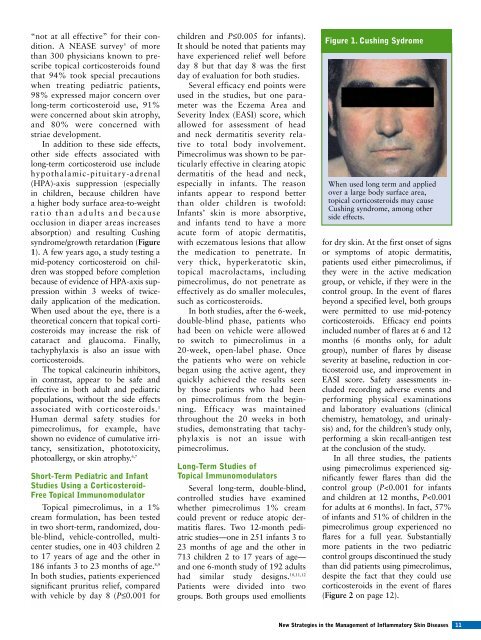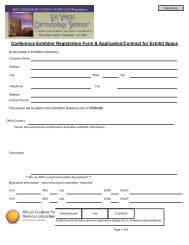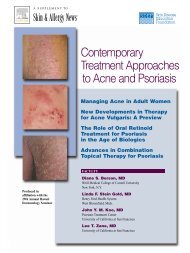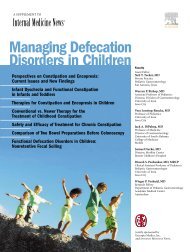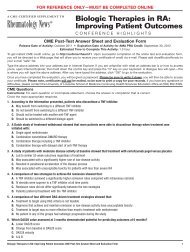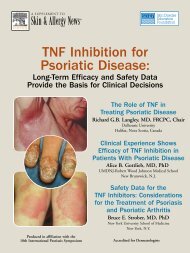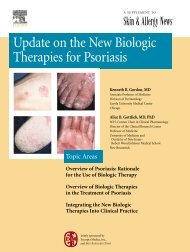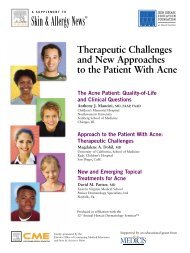Skin & Allergy News® - Global Academy for Medical Education
Skin & Allergy News® - Global Academy for Medical Education
Skin & Allergy News® - Global Academy for Medical Education
Create successful ePaper yourself
Turn your PDF publications into a flip-book with our unique Google optimized e-Paper software.
“not at all effective” <strong>for</strong> their condition.A NEASE survey 5 of morethan 300 physicians known to prescribetopical corticosteroids foundthat 94% took special precautionswhen treating pediatric patients,98% expressed major concern overlong-term corticosteroid use, 91%were concerned about skin atrophy,and 80% were concerned withstriae development.In addition to these side effects,other side effects associated withlong-term corticosteroid use includehypothalamic-pituitary-adrenal(HPA)-axis suppression (especiallyin children, because children havea higher body surface area-to-weightratio than adults and becauseocclusion in diaper areas increasesabsorption) and resulting Cushingsyndrome/growth retardation (Figure1). A few years ago, a study testing amid-potency corticosteroid on childrenwas stopped be<strong>for</strong>e completionbecause of evidence of HPA-axis suppressionwithin 3 weeks of twicedailyapplication of the medication.When used about the eye, there is atheoretical concern that topical corticosteroidsmay increase the risk ofcataract and glaucoma. Finally,tachyphylaxis is also an issue withcorticosteroids.The topical calcineurin inhibitors,in contrast, appear to be safe andeffective in both adult and pediatricpopulations, without the side effectsassociated with corticosteroids. 1Human dermal safety studies <strong>for</strong>pimecrolimus, <strong>for</strong> example, haveshown no evidence of cumulative irritancy,sensitization, phototoxicity,photoallergy, or skin atrophy. 6,7Short-Term Pediatric and InfantStudies Using a Corticosteroid-Free Topical ImmunomodulatorTopical pimecrolimus, in a 1%cream <strong>for</strong>mulation, has been testedin two short-term, randomized, double-blind,vehicle-controlled, multicenterstudies, one in 403 children 2to 17 years of age and the other in186 infants 3 to 23 months of age. 8,9In both studies, patients experiencedsignificant pruritus relief, comparedwith vehicle by day 8 (P≤0.001 <strong>for</strong>children and P≤0.005 <strong>for</strong> infants).It should be noted that patients mayhave experienced relief well be<strong>for</strong>eday 8 but that day 8 was the firstday of evaluation <strong>for</strong> both studies.Several efficacy end points wereused in the studies, but one parameterwas the Eczema Area andSeverity Index (EASI) score, whichallowed <strong>for</strong> assessment of headand neck dermatitis severity relativeto total body involvement.Pimecrolimus was shown to be particularlyeffective in clearing atopicdermatitis of the head and neck,especially in infants. The reasoninfants appear to respond betterthan older children is twofold:Infants’ skin is more absorptive,and infants tend to have a moreacute <strong>for</strong>m of atopic dermatitis,with eczematous lesions that allowthe medication to penetrate. Invery thick, hyperkeratotic skin,topical macrolactams, includingpimecrolimus, do not penetrate aseffectively as do smaller molecules,such as corticosteroids.In both studies, after the 6-week,double-blind phase, patients whohad been on vehicle were allowedto switch to pimecrolimus in a20-week, open-label phase. Oncethe patients who were on vehiclebegan using the active agent, theyquickly achieved the results seenby those patients who had beenon pimecrolimus from the beginning.Efficacy was maintainedthroughout the 20 weeks in bothstudies, demonstrating that tachyphylaxisis not an issue withpimecrolimus.Long-Term Studies ofTopical ImmunomodulatorsSeveral long-term, double-blind,controlled studies have examinedwhether pimecrolimus 1% creamcould prevent or reduce atopic dermatitisflares. Two 12-month pediatricstudies—one in 251 infants 3 to23 months of age and the other in713 children 2 to 17 years of age—and one 6-month study of 192 adultshad similar study designs. 10,11,12Patients were divided into twogroups. Both groups used emollientsFigure 1. Cushing SydromeWhen used long term and appliedover a large body surface area,topical corticosteroids may causeCushing syndrome, among otherside effects.<strong>for</strong> dry skin. At the first onset of signsor symptoms of atopic dermatitis,patients used either pimecrolimus, ifthey were in the active medicationgroup, or vehicle, if they were in thecontrol group. In the event of flaresbeyond a specified level, both groupswere permitted to use mid-potencycorticosteroids. Efficacy end pointsincluded number of flares at 6 and 12months (6 months only, <strong>for</strong> adultgroup), number of flares by diseaseseverity at baseline, reduction in corticosteroiduse, and improvement inEASI score. Safety assessments includedrecording adverse events andper<strong>for</strong>ming physical examinationsand laboratory evaluations (clinicalchemistry, hematology, and urinalysis)and, <strong>for</strong> the children’s study only,per<strong>for</strong>ming a skin recall-antigen testat the conclusion of the study.In all three studies, the patientsusing pimecrolimus experienced significantlyfewer flares than did thecontrol group (P


